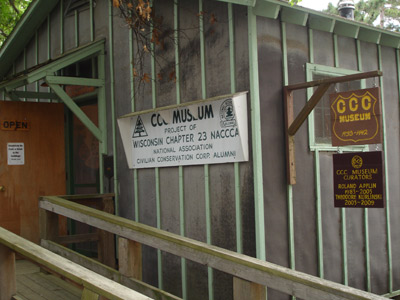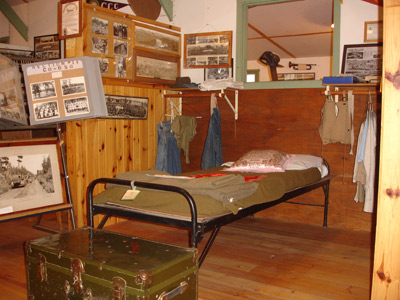FENCEROWS...Remembering the Civil Conservation Corps
By John Luthens
The foundations of Wisconsin’s natural resources spiral deep back into the past like the cross section of an ancient tree.
Rolling miles of rebuilt forest, grasses and streamside cover now stretch across the state, replenishing a nation built from northern lumber and the pocketbooks of the lumber barons who clear-cut endless tracts of land.
In the early 1900’s, a high percentage of the logged over clearings were sold as farmland “stump pastures,” with poor farming practices leading to more and more clearing of surrounding vegetation and natural habitat.
Fire and erosion were inevitable in the cutover scrub wastelands at the turn of the nineteenth century. It swept with the winds of progress across vast acres of our great state. Drought followed, and it was a drought that ran many farms into the ground. Coupled with a toppled stock market, the country sank into the withered years of the Great Depression. Acres of barren land were left delinquent.
These things are set down as hard facts in the history books.
Then there was the resilience of the generation who grew to maturity over the span of two world wars; a resilience always evident but harder to nail down into the actual pages of history; a resilience born in the fields and forests of Wisconsin, rebuilding a bridge from the past glory of Wisconsin, and indeed the past glory of the entire United States.
It came through the building of roads and dams, through fire towers and fire lanes and the reseeding of trees. It came through the birth of state parks out of abandoned land, bringing the lost age of virgin wilderness into the future resources that we see today.
If you have traveled about in Wisconsin, over scenic waterways or down remote logging trails, or throughout the network of county and state parks, then you have likely wandered past the wooden signs: “Former Site of CCC Camp.”
The resilience of a generation was given a name in the Civilian Conservation Corps, which in the interest of book keeping amounted to $30 a month plus camp accommodations. But the intangible things of the CCC, what they saw and the things they did, what they learned and where they went when it was all said and done; that is not the stuff of book-learning history. That is the stuff of legend.
Depression-era restrictions on jobs and income required that the few available jobs go to “heads of families,” which left young men of the era, the ones who were leaving home for perhaps the first time, many with only moderate levels of education, no means of income, and for many, no real idea how to function as part of a social unit outside the comfort of their own families.
President Franklin D. Roosevelt instituted the CCC in 1933 as a means of providing jobs to young men, stimulating the country’s bleak economy and at the same time initiating a natural resource conservation program. For many of the men, it was their first time working in a group environment. It was their first time working as part of a team.
While working to rebuild the land was a common goal for the men of the CCC, it was also a gentler time of honest work and outdoor experience. It was an afternoon shadow before the darkness of World War II came along and ultimately put an end to the depression and to the CCC. A great majority of the conservation workers were drafted into service or volunteered. For the brave men who never came back from the battlefronts, the CCC may have been their last and greatest peacetime memory.
There were few Depression-era work programs that could rival the enthusiasm and hard work of the Civilian Conservation Corps. According to the CCC museum in Rhinelander, Wisconsin, from 1933 through 1942, the CCC assigned nearly 165,000 men to 128 camps throughout the state.
Opened in 1983, with donations from wood processing companies, timber businesses, CCC alumni and the U.S. Forest Service, the Rhinelander museum captures the Wisconsin men who helped build the parks, trails and forests that set Wisconsin into the premiere outdoor-tourism destination that it is today.
The museum was donated to the city of Rhinelander and it is now part of the Pioneer Park Historical Complex. A mixture of paid staff and volunteers help run the historical exhibits from the last week in May to the first week in September.
 |
 |
| The CCC museum in Rhinelander, Wisconsin. | Replicated bunkhouse inside the CCC museum |
The CCC museum is a glimpse back into history, perhaps best characterized by a cross section of an eastern white pine that is on display in a corner of a replicated camp barracks. The pine was renamed the MacAurthur Pine in honor of General Douglas MacAurthur in 1945. The circumference of the base was nearly 18 feet when it finally fell in 2001. Terry Urbonya, one of the museum’s volunteer staff, pointed his way down the stump rings and told me the history.
“That tree was over 400 years old when it finally fell,” Urbonya said. “You can tell by the cracks in the rings that it was struck by lightning 3 times. The rings go back to the time of Pocahontas and clear through both World Wars. The tree was still alive and going skyward when Neil Armstrong first set foot on the moon.”
A tree section like that has seen history. It is simple enough to look at the rings, but to contemplate them can take a lifetime. Through the doors of the CCC museum, it is possible to step back in time and become lost in the hundreds of pieces of memorabilia and the faded legacy of countless photographs in the museum, thinking how the tools were used and the valuable skills learned, thinking through the pictures and wondering about the price of freedom that we enjoy in the outdoor world today.
There are well-used tools and pumps that were used to battle forest fires and irrigate the massive plantations of trees that the CCC set in the Wisconsin earth. There are old cots and footlocker from the barracks-style camps that were set up in some of the wildest areas of Wisconsin that have today become some of the most scenic and most visited. There is even an old wooden garage that houses a 1940 International KB-5 Forest Service truck.
Hundreds of photographs capture the lives of young men making their way into a sun-drenched world of pine plantations and pristine lakes, learning valuable skills in outdoor world that was slowly spinning them onto the most vicious battlefronts in history.
Pictures and box-scores of organized baseball and basketball teams pop up in CCC albums, along with pictures of fish caught in the lakes and men standing happy alongside of each other, even though there faces are black with soot from fighting a wildfire under intense summer heat.
Fire towers built, footbridges put down, vocational skills learned; the CCC put forth more into the foundations of history than the simple planting of trees and simple land ethic conservation. It put down a value system of hard work and sacrifice that is as deeply ingrained in our history and as hard to destroy as the old MacArthur Pine in the Rhinelander museum barracks.
The legacy of the Civilian Conservation Corps is more than memories in a museum. It stands as a testament to what people working together in our great country can accomplish.
Now, in a more modern age, and with many people rolling into the freedom of an outdoor world of Wisconsin over an Independence Day weekend, I hope we remember what the past has taught us of conservation and at what cost that learning and freedom was bought.









